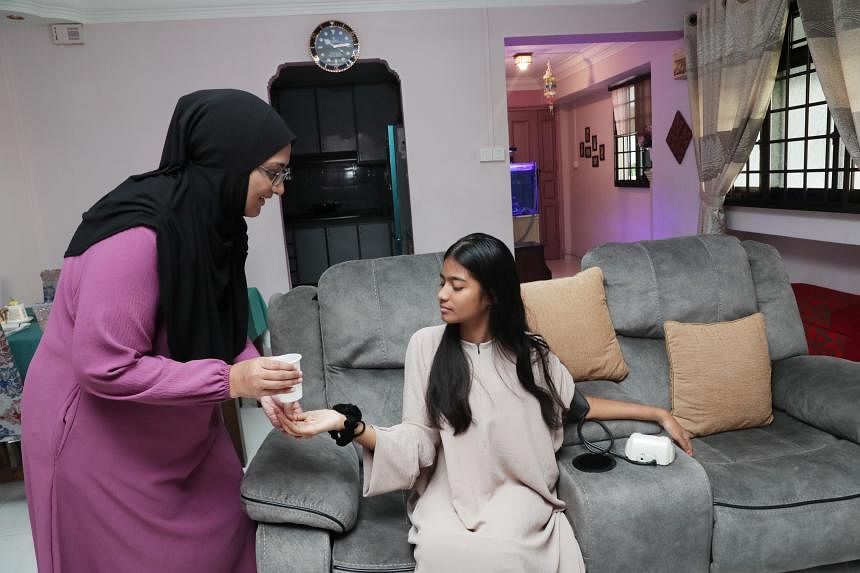SINGAPORE – A pilot for virtual wards has been expanded to include four more public healthcare institutions, enabling more patients with a wider range of conditions to receive hospital-type care in the comfort of their homes.
Called the Mobile Inpatient Care at Home (MIC@Home), the pilot is now available at Changi General Hospital, KK Women’s and Children’s Hospital (KKH), Sengkang General Hospital (SKH) and Tan Tock Seng Hospital, said the Ministry of Health Office for Healthcare Transformation (MOHT) on Monday.
This means that all public hospitals in Singapore, except the Institute of Mental Health (IMH), can offer MIC@Home to suitable patients. The plan is for IMH to offer it to suitable patients at a later date.
Patients receiving treatment at home – or in a virtual ward – have round-the-clock access to care delivered by a team of healthcare professionals via teleconsultations and home visits, until they are deemed fit for discharge.
Clinical care such as intravenous medication and blood tests can be administered at home.
Should a patient’s condition deteriorate, he can be transferred to a hospital.
As at June 2023, around 1,000 patients have been admitted to the programme, staying for seven days on average and resulting in an estimated saving of 7,000 bed days. By the year end, more than 2,000 patients would have experienced the virtual wards, said MOHT’s assistant director and project lead, Mr Lai Yi Feng.
He said the care model is being progressively scaled up, and will likely become a mainstream option in the next few years to help address the fast-growing healthcare needs in Singapore.
When the pilot started in April 2022 at the National University Health System (NUHS), Singapore General Hospital and Khoo Teck Puat Hospital (KTPH), it was for selected patients with conditions classified under general medicine – such as skin infections, urinary tract infections and congestive heart failure with fluid overload.
It was not just inpatients who were transferred to virtual wards; some emergency department patients were admitted too. In particular, around half of the virtual ward patients at KTPH came from the emergency department, said Mr Lai.
Now, more types of patients can be cared for at home, including children with common conditions such as dengue fever, skin infections, eczema and urinary tract infections, and those undergoing elective surgery, among others.
SKH recently started the pilot for emergency department patients to reduce the wait time for a bed, and plans to expand it to include elderly patients with higher care needs from inpatient wards.
To be eligible for the virtual wards, patients must live in the vicinity of SKH, have stable medical conditions and are highly motivated to care for themselves, among other criteria, said SKH@Home clinician lead, Adjunct Assistant Professor Jean Lee.
NUHS plans to expand its virtual wards to include children in paediatric care.
Its virtual ward patients currently include dengue fever patients who require intravenous drips and Covid-19 patients with weakened immune systems.
When 13-year-old Nur Sameera Begum Shaik Sulaiman developed a high fever due to a kidney infection in late July, she spent the last three days of her one-week stay at KKH in the comfort of her home.
Her mother, Madam Nurzahirah Sulaiman, who is a nurse, said she was advised to take her daughter to the hospital immediately if her temperature shot up again and she was in pain, for example.
Madam Nurzahirah took home a bag of equipment that included a pulse oximeter, a non-contact thermometer and a blood pressure machine. She also downloaded a phone app so she could upload various data, such as blood pressure readings, to monitor her daughter’s condition three times a day.
During the three days at home, they had seven visits from a nurse who gave Sameera the antibiotics for her infection. They also saw the doctor online every morning.
“It was a pleasant experience, and can be recommended for those patients who are stable and have caregivers who are competent,” said Madam Nurzahirah, who added that a courier collected the equipment after her daughter was discharged.
Currently, all virtual ward patients enjoy B2 ward subsidies.
The initiative is managed by MOHT and supported by the Health Ministry’s MIC@Home Regulatory and Financing Sandbox.
With the expansion, more technological solutions will be adopted, such as wearable monitoring devices for children as young as six years old.
“Without technology, it may mean a lot more manpower-intensive activities,” said Mr Lai.
“So in this case, we have been trying to look at technology to see how we can make use of (tech solutions) to reduce our reliance on human sources.”


